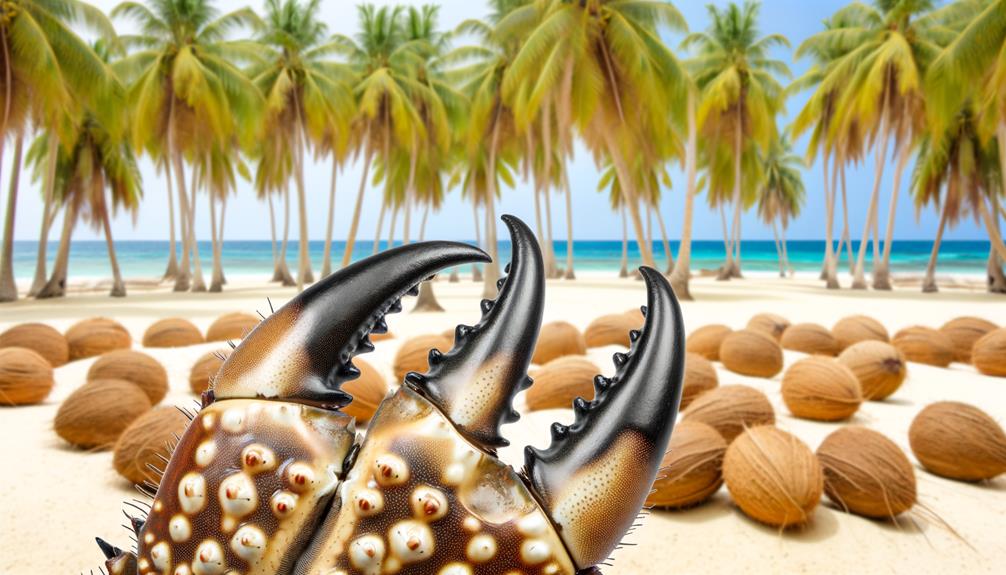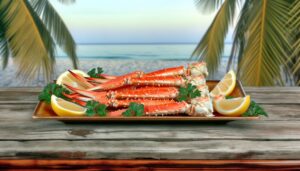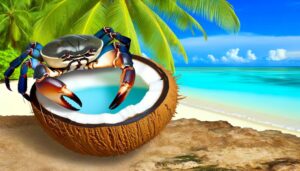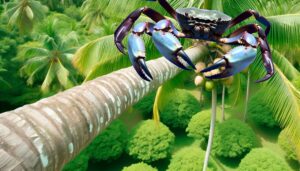Do Coconut Crabs Live in Australia: A Wildlife Guide
Coconut crabs don't have teeth. Instead, they utilize their robust mandibles to crush and cut food.
These mandibles, powered by strong adductor muscles, generate forces exceeding 740 newtons, ideal for pulverizing tough materials. Coconut crabs also have powerful chelae that can exert up to 3,300 newtons, used for cracking open hard shells.
Their specialized mouthparts, including maxillipeds and maxillae, manipulate and transport food, facilitating efficient nutrient absorption. The combination of powerful claws and mandibles allows coconut crabs to dominate their ecological niche.
Understanding these adaptations sheds light on their evolutionary success and resource exploitation strategies.

Key Takeaways
- Coconut crabs do not have teeth; they have mandibles for crushing and slicing.
- The mandibles are powerful and can generate forces exceeding 740 newtons.
- The mandibles have calcified edges designed for pulverizing tough materials.
- Coconut crabs use their mandibles, not teeth, for breaking down food.
- Mandibles are essential for nutrient absorption and grinding action.
Anatomy of Coconut Crabs
Coconut crabs, Birgus latro, exhibit a robust anatomy characterized by a hard exoskeleton and well-developed pincers. These crustaceans possess a carapace that can reach up to 40 cm in length, providing significant protection. Their pincers, or chelae, are particularly powerful, capable of exerting force up to 3300 newtons, making them the strongest among terrestrial arthropods.
The crabs' limbs are segmented into five pairs, with the first pair modified into large, crushing pincers. The remaining pairs facilitate locomotion and manipulation of objects. Unique to coconut crabs, their pleopods have adapted for respiration, functioning as pseudo-lungs. This adaptation allows them to thrive in terrestrial environments, although they must remain moist to facilitate gas exchange efficiently.
Mouthparts Explained
In addition to their formidable pincers, coconut crabs possess specialized mouthparts that play an essential role in their ability to feed and process food efficiently. These mouthparts include maxillipeds, mandibles, and maxillae, each contributing to different aspects of feeding behavior. Maxillipeds assist in manipulating food, while mandibles provide crushing force. Maxillae function to transport food particles towards the mouth.
| Mouthpart | Function |
|---|---|
| Maxillipeds | Manipulate and handle food |
| Mandibles | Crush and cut food |
| Maxillae | Transport food particles |
Their mouthparts are equipped with sensory structures, enhancing their ability to detect and process various food sources. This intricate arrangement guarantees that coconut crabs can efficiently exploit a wide range of dietary options within their environment.
Mandibles Function
Mandibles, equipped with robust crushing capabilities, serve as the primary tools for breaking down food into manageable pieces for further processing.
In coconut crabs, the mandibles are highly specialized, featuring calcified edges that enhance their ability to pulverize tough materials like coconut husks. These structures are powered by strong adductor muscles, enabling considerable force application during feeding.
Research indicates that the mandibles' efficiency in breaking down organic matter is essential for nutrient absorption. By repeatedly opening and closing, the mandibles create a grinding action, which reduces food particle size, facilitating enzymatic action in subsequent digestive stages.
Their significant role in mechanical digestion underscores their evolutionary adaptation to the coconut crab's unique dietary habits.
Chelae: The Claws
The chelae, or claws, of coconut crabs exhibit remarkable strength and dexterity, playing an important role in their feeding and defense mechanisms. Each chela can exert a force up to 3,300 newtons, making them one of the most powerful pinchers among terrestrial animals.
These claws are highly adapted for manipulating various objects with precision, owing to their robust musculature and specialized exoskeleton structure. The larger chela, typically the left one, is used for crushing, while the smaller chela assists in more delicate tasks.
This bilateral specialization allows coconut crabs to effectively interact with their environment, enabling them to crack open hard shells and defend against predators. Their chelae's unparalleled strength underscores their evolutionary success.
Feeding Mechanisms
Coconut crabs utilize their powerful chelae to crack open hard-shelled coconuts, demonstrating significant mechanical advantage and force generation.
Their dietary preferences extend beyond coconuts to include a variety of organic material such as fruits, carrion, and smaller animals.
These feeding mechanisms highlight their adaptability and ecological versatility in resource acquisition.
Powerful Claw Adaptations
Despite lacking traditional teeth, coconut crabs possess extraordinarily powerful claws that enable them to exert immense force, effectively cracking open hard-shelled prey. These adaptations are essential for their survival and feeding efficiency. Research indicates that the claws can generate a force of up to 3,300 newtons, making them one of the strongest among terrestrial crustaceans.
Key adaptations include:
- Robust chelae structure: The claws' anatomy is reinforced with dense exoskeletal material, providing strength and durability.
- Muscle hypertrophy: Enhanced muscle mass within the claws allows for significant force generation.
- Forceful closing mechanism: The biomechanical design facilitates rapid and powerful closing, essential for breaking tough exteriors.
These specialized adaptations underscore the coconut crab's evolutionary success in exploiting hard-shelled food resources.
Dietary Preferences Explained
Understanding coconut crabs' dietary preferences reveals their specialized feeding mechanisms, which are adapted to efficiently exploit a diverse range of food sources. These crustaceans primarily consume seeds, nuts, fruits, and the occasional carrion. Their powerful chelae (claws) enable them to crack open hard-shelled coconuts, a feat few other species can accomplish.
Additionally, coconut crabs exhibit keen olfactory senses, allowing them to locate food over considerable distances. They also possess maxillipeds, appendages that assist in manipulating and ingesting food. Research indicates that their diet is opportunistic, varying with available resources, which underscores their role as critical recyclers in their ecosystems.
This dietary versatility guarantees coconut crabs' survival in diverse habitats, from coastal areas to forest interiors.
Diet of Coconut Crabs
Coconut crabs exhibit omnivorous feeding behaviors, primarily consuming fruits, nuts, seeds, and occasionally carrion. Their robust pincers enable them to access a variety of food sources, including cracking open coconuts, which are a significant part of their diet.
Nutritional studies indicate their diet provides essential proteins, fats, and minerals necessary for growth and reproduction.
Preferred Food Sources
Feeding primarily on fallen fruits, nuts, and carrion, coconut crabs exhibit a diverse omnivorous diet. These crustaceans display a remarkable ability to exploit various food sources to meet their nutritional needs.
Their preferred food sources can be categorized as follows:
- Plant Material: Coconut crabs consume a variety of plant matter, including coconuts, pandanus fruits, and other fallen fruits.
- Animal Matter: They scavenge on deceased animals and are known to consume other crabs and small vertebrates when available.
- Human Refuse: In areas with human activity, coconut crabs will opportunistically feed on discarded food and waste.
Feeding Mechanisms
Equipped with powerful pincers, coconut crabs can exert significant force to crack open hard-shelled food sources like coconuts. Their pincers, or chelae, generate force up to 3,300 newtons, enabling them to access otherwise impenetrable food.
Studies have shown that coconut crabs use a combination of mechanical advantage and strategic positioning to maximize efficiency in shell-breaking. They also exhibit keen sensory perception, locating food through chemoreception and tactile cues.
Additionally, coconut crabs employ their second pair of walking legs, modified into specialized appendages, to manipulate and process food. These adaptations facilitate the consumption of diverse dietary items including fruits, nuts, and small animals.
Therefore, coconut crabs have evolved specialized feeding mechanisms to exploit a wide range of ecological niches.
Nutritional Requirements
Surprisingly, research shows that coconut crabs' diets are highly diverse and include a mix of plant and animal matter, optimizing their nutritional intake. They primarily consume fruits, nuts, seeds, and the pith of fallen trees. However, they also exhibit opportunistic carnivory, preying on smaller animals and scavenging carrion. This dietary flexibility ensures they meet their nutritional needs across various environmental conditions.
Key dietary components include:
- Plant Matter: Fruits like coconuts, pandanus, and nuts.
- Animal Matter: Small vertebrates, carrion, and other invertebrates.
- Decaying Organic Matter: Fallen leaves and decomposing wood.
This varied diet provides essential macronutrients and micronutrients, promoting their robust exoskeletons and overall health.
Understanding these dietary requirements is important for conservation efforts and habitat management.
Strength Vs. Teeth
In comparison to their formidable strength, coconut crabs possess mandibles rather than teeth, which they use to exert one of the strongest pinching forces measured in any terrestrial animal. Their mandibles can generate forces exceeding 740 newtons, equivalent to the bite force of a large dog. This immense strength enables them to crack open hard-shelled coconuts, their primary food source.
Unlike typical teeth, their mandibles are robust, calcified structures adapted for crushing and slicing. Researchers have noted that these powerful appendages allow coconut crabs to dominate their ecological niche. The significant difference between having teeth and possessing strong mandibles highlights their unique evolutionary adaptation, providing them with a mechanical advantage over other species relying on less forceful feeding mechanisms.
Adaptations for Eating
Coconut crabs exhibit a range of specialized adjustments for eating, primarily through their robust mandibles and strong olfactory senses. Their mandibles, which function similarly to teeth, enable them to pulverize tough materials like coconuts. These adjustments guarantee they can efficiently exploit available resources.
Key eating adjustments include:
- Powerful chelae: Capable of exerting force up to 3,300 Newtons, allowing them to crack open hard shells.
- Chemoreception: Enhanced olfactory receptors help locate food over long distances, essential for their scavenging lifestyle.
- Behavioral flexibility: Ability to climb trees and drop coconuts to the ground, facilitating easier access to the food inside.
These adjustments collectively ensure that coconut crabs can thrive in their ecological niche, overcoming the physical challenges posed by their preferred diet.
Comparative Anatomy
While coconut crabs' feeding adaptations are impressive, their comparative anatomy reveals fascinating distinctions from other crustaceans, particularly in their robust exoskeletons and unique respiratory structures.
Coconut crabs possess an exceptionally thick exoskeleton, providing enhanced protection and support. This exoskeleton is structurally reinforced by calcium carbonate deposits, making it one of the strongest among crustaceans.
Additionally, their respiratory system diverges significantly. Unlike aquatic crabs with gills, coconut crabs have branched respiratory organs called branchiostegal lungs, suited for terrestrial life. These organs facilitate efficient gas exchange in a terrestrial environment, allowing them to thrive on land.
The crab's powerful pincers, capable of exerting up to 750 N of force, further distinguish them anatomically, enabling effective predation and manipulation of their environment.
Evolutionary Insights
Researchers have traced the evolutionary lineage of coconut crabs, revealing significant adaptations that differentiate them from their aquatic ancestors. These adaptations have enabled them to thrive in terrestrial environments.
Importantly, coconut crabs exhibit:
- Exoskeletal Reinforcement: Enhanced calcification provides structural support and protection.
- Respiratory Adaptations: Modified gills facilitate efficient air-breathing, essential for terrestrial survival.
- Feeding Mechanisms: Powerful claws and specialized mouthparts replace aquatic feeding structures, allowing them to crack open coconuts and other hard-shelled prey.
These evolutionary advancements underscore the coconut crab's shift from an aquatic to a terrestrial lifestyle, highlighting natural selection's role in shaping species over time. Their unique adaptations exemplify evolutionary processes, making them an intriguing subject for further study in evolutionary biology and ecology.
Conclusion
Essentially, coconut crabs don't possess traditional teeth. Instead, their powerful mandibles act as nature's vice grips, effortlessly cracking open coconuts with surgical precision.
Their robust chelae, akin to industrial pincers, further enhance their feeding capabilities. Adapted to their environment through evolutionary ingenuity, these crabs epitomize nature's engineering marvels, blending sheer strength with specialized anatomy.
Ultimately, the absence of teeth is compensated by their formidable, multifunctional mouthparts, tailored perfectly for their survival and dietary demands.






